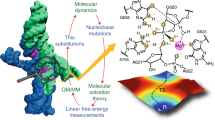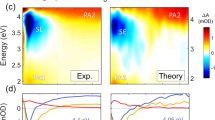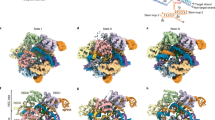Abstract
We have used single-molecule spectroscopy to untangle conformational dynamics and internal chemistry in the hairpin ribozyme. The active site of the ribozyme is stably formed by docking two internal loops, but upon cleavage undocking is accelerated by two orders of magnitude. The markedly different kinetic properties allow us to differentiate cleaved and ligated forms, and thereby observe multiple cycles of internal cleavage and ligation of a ribozyme in a uniquely direct way. The position of the internal equilibrium is biased toward ligation, but the cleaved ribozyme undergoes several undocking events before ligation, during which products may dissociate. Formation of the stably docked active site, rapid undocking after cleavage, and a strong bias toward ligation should combine to generate a stable circular template for the synthesis of the viral (+) strand and thus ensure a productive replication cycle.
This is a preview of subscription content, access via your institution
Access options
Subscribe to this journal
Receive 12 print issues and online access
$189.00 per year
only $15.75 per issue
Buy this article
- Purchase on Springer Link
- Instant access to full article PDF
Prices may be subject to local taxes which are calculated during checkout







Similar content being viewed by others
References
Doudna, J.A. & Cech, T.R. The chemical repertoire of natural ribozymes. Nature 418, 222–228 (2002).
Lilley, D.M. The origins of RNA catalysis in ribozymes. Trends Biochem. Sci. 28, 495–501 (2003).
Fedor, M.J. Tertiary structure stabilization promotes hairpin ribozyme ligation. Biochemistry 38, 11040–11050 (1999).
McLeod, A.C. & Lilley, D.M. Efficient, pH-dependent RNA ligation by the VS ribozyme in trans. Biochemistry 43, 1118–1125 (2004).
Stage-Zimmermann, T.K. & Uhlenbeck, O.C. A covalent crosslink converts the hammerhead ribozyme from a ribonuclease to an RNA ligase. Nat. Struct. Biol. 8, 863–867 (2001).
Fedor, M.J. Structure and function of the hairpin ribozyme. J. Mol. Biol. 297, 269–291 (2000).
Murchie, A.I.H., Thomson, J.B., Walter, F. & Lilley, D.M.J. Folding of the hairpin ribozyme in its natural conformation achieves close physical proximity of the loops. Mol. Cell 1, 873–881 (1998).
Rupert, P.B. & Ferre-D'Amare, A.R. Crystal structure of a hairpin ribozyme-inhibitor complex with implications for catalysis. Nature 410, 780–786 (2001).
Walter, N.G., Burke, J.M. & Millar, D.P. Stability of hairpin ribozyme tertiary structure is governed by the interdomain junction. Nat. Struct. Biol. 6, 544–549 (1999).
Berzal-Herranz, A., Joseph, S., Chowrira, B.M., Butcher, S.E. & Burke, J.M. Essential nucleotide sequences and secondary structure elements of the hairpin ribozyme. EMBO J. 12, 2567–2573 (1993).
Zhao, Z.Y., Wilson, T.J., Maxwell, K. & Lilley, D.M.J. The folding of the hairpin ribozyme: Dependence on the loops and the junction. RNA 6, 1833–1846 (2000).
Tan, E. et al. A four way junction accelerates hairpin ribozyme folding via a discrete intermediate. Proc. Natl. Acad. Sci. USA 100, 9308–9313 (2003).
Hohng, S. et al. Conformational flexibility of four-way junctions in RNA. J. Mol. Biol. 336, 69–79 (2004).
Zhuang, X. et al. Correlating structural dynamics and function in single ribozyme molecules. Science 296, 1473–1476 (2002).
Rupert, P.B., Massey, A.P., Sigurdsson, S.T. & Ferre-D'Amare, A.R. Transition state stabilization by a catalytic RNA. Science 298, 1421–1424 (2002).
Walter, N.G., Hampel, K.J., Brown, K.M. & Burke, J.M. Tertiary structure formation in the hairpin ribozyme monitored by fluorescence resonance energy transfer. EMBO J. 17, 2378–2391 (1998).
Hegg, L.A. & Fedor, M.J. Kinetics and thermodynamics of intermolecular catalysis by hairpin ribozymes. Biochemistry 34, 15813–15828 (1995).
Donahue, C.P. & Fedor, M.J. Kinetics of hairpin ribozyme cleavage in yeast. RNA 3, 961–973 (1997).
Yadava, R.S., Choi, A.J., Lebruska, L.L. & Fedor, M.J. Hairpin ribozymes with four-way helical junctions mediate intracellular RNA ligation. J. Mol. Biol. 309, 893–902 (2001).
Rueda, D. et al. Single-molecule enzymology of RNA: essential functional groups impact catalysis from a distance. Proc. Natl. Acad. Sci. USA 101, 10066–10071 (2004).
Bokinsky, G. et al. Single-molecule transition-state analysis of RNA folding. Proc. Natl. Acad. Sci. USA 100, 9302–9307 (2003).
Kuzmin, Y.I., Da Costa, C.P. & Fedor, M.J. Role of an active site guanine in hairpin ribozyme catalysis probed by exogenous nucleobase rescue. J. Mol. Biol. 340, 233–251 (2004).
Ryder, S.P. et al. Investigation of adenosine base ionization in the hairpin ribozyme by nucleotide analog interference mapping. RNA 7, 1454–1463 (2001).
Bruening, G., Passmore, B.K. van Tol, H., Buzayan, J.M. & Feldstein, P.A. Replication of a plant virus satellite RNA: evidence favors transcription of circular templates of both polarities. Mol. Plant Microbe Interact. 4, 219–225 (1991).
Van Tol, H., Buzayan, J.M. & Bruening, G. Evidence for spontaneous circle formation in the replication of the satellite RNA of tobacco ringspot virus. Virology 180, 23–30 (1991).
Hampel, A. & Tritz, R. RNA catalytic properties of the minimum (−)sTRSV sequence. Biochemistry 28, 4929–4933 (1989).
Wilson, T.J. & Lilley, D.M. Metal ion binding and the folding of the hairpin ribozyme. RNA 8, 587–600 (2002).
Hertel, K.J., Herschlag, D. & Uhlenbeck, O.C. A kinetic and thermodynamic framework for the hammerhead ribozyme reaction. Biochemistry 33, 3374–3385 (1994).
Okumus, B., Wilson, T.J., Lilley, D.M.J. & Ha, T. Vesicle encapsulation studies reveal that single molecule ribozyme heterogeneities are intrinsic. Biophys. J. 87, 2798–2806 (2004).
Benesch, R.E. & Benesch, R. Enzymatic removal of oxygen for polarography and related methods. Science 118, 447–448 (1953).
Acknowledgements
Funding was provided by the US National Science Foundation (NIH) (PHY-0134916, DBI-0215869, T.H.), by the US National Institutes of Health (GM065367, T.H.), and by Cancer Research-UK (D.M.J.L.). M.K.N. was partially supported by the NIH molecular biophysics training grant (T32GM008276).
Author information
Authors and Affiliations
Corresponding authors
Ethics declarations
Competing interests
The authors declare no competing financial interests.
Supplementary information
Supplementary Fig. 1
Histograms of the structural dynamics of the cleaved ribozyme obtained from the simple ligation experiment. (PDF 16 kb)
Supplementary Fig. 2
Duration of the cleaved state in the multiple cycles experiment. (PDF 11 kb)
Supplementary Fig. 3
pH-dependence of docking and undocking rates of the cleaved ribozyme. (PDF 22 kb)
Supplementary Fig. 4
pH-dependence of the apparent cleavage rate. (PDF 11 kb)
Rights and permissions
About this article
Cite this article
Nahas, M., Wilson, T., Hohng, S. et al. Observation of internal cleavage and ligation reactions of a ribozyme. Nat Struct Mol Biol 11, 1107–1113 (2004). https://doi.org/10.1038/nsmb842
Received:
Accepted:
Published:
Issue Date:
DOI: https://doi.org/10.1038/nsmb842
This article is cited by
-
Single-Molecule Characterization of Cy3.5 -Cy5.5 Dye Pair for FRET Studies of Nucleic Acids and Nucleosomes
Journal of Fluorescence (2023)
-
Single-molecule Förster resonance energy transfer studies of RNA structure, dynamics and function
Biophysical Reviews (2009)
-
Do-it-yourself guide: how to use the modern single-molecule toolkit
Nature Methods (2008)
-
Dissecting metal ion–dependent folding and catalysis of a single DNAzyme
Nature Chemical Biology (2007)
-
Ribozymes, riboswitches and beyond: regulation of gene expression without proteins
Nature Reviews Genetics (2007)



